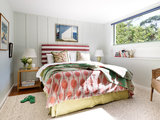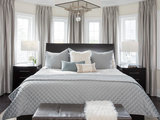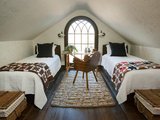


A bedspread is the general name given to basically all pre-filled bed covers intended for use as the top layer on a bed. Comforters, quilts and coverlets fall into that category. They can be both decorative and warming, thick or lighter weight, in a variety of fabric.
They are generally used alone, with only a sheet and any blankets you need underneath, but also they can be layered for decorative purposes.
Thick and (sometimes) quilted, a comforter differs from a quilt in that colors are generally dyed and patterns are not embroidered. Comforters are filled with layers of material including polyester batting (a synthetic fiber), down feathers, wool or silk. The loft (thickness) of the filling determines the weight as well as the level of insulation.
Comforters are stitched or quilted to secure the filling and to ensure that it is evenly distributed. They are intended to be the bedspread, sitting on top of sheets, but again, those who want to create a layered look should go ahead and do it. There are no cardinal rules to be broken in bedding.
Traditionally composed of three layers of fiber, quilts consist of a woven cloth top, a layer of batting and a woven back, all stitched together in decorative patterns. Different from other forms of bed covers because they are generally pieced together with many pieces of cloth, quilts are occasionally found with a single piece of fabric on the top (a whole-cloth quilt).
There are numerous classic patterns and traditions regarding the design and characteristics of quilts. Many are made or given to mark important life events such as marriage, the birth of a child, a family member leaving home, and graduations.
Modern quilts are not always intended for use as bedding, and may be used as throws, wall hangings, table runners or tablecloths.
A duvet is essentially a soft flat bag filled with down, feathers or a synthetic alternative. It is recommended that duvets are inserted into a removable cover, much like a pillow and pillow case.
Duvets and covers are designed to be used alone (with no sheets) because the insert can be removed and the outer “bag” can be laundered, but many people use them with sheets anyway. Many people like duvets because they reduce the complexity of making a bed, as it is a single cover.
Duvet covers often come with the option of matching shams, but mixing it up is an easy way to create a gorgeous bed that looks like it was effortlessly tossed together.
A coverlet is a lightweight, non-reversible bedspread that is usually either quilted or woven. Classically designed as a decorative layer to go over thicker bedspreads, coverlets often have a thin layer of batting, making them appropriate for use as a stand-alone bed covering, depending on the weight. They can also be used as throws on a bed or sofa.
Due to their size and decorative quality, they are not designed to achieve a pillow tuck, as some bedspreads are. A coverlet often has coordinating shams, but again, it is most certainly not necessary to match.
Blankets add color, texture (or both) in addition to casual coziness when tossed haphazardly (but beautifully) on the bed. In this design, a throw blanket at the end of the bed adds just enough texture and an additional layer to make the composition interesting and inviting.
